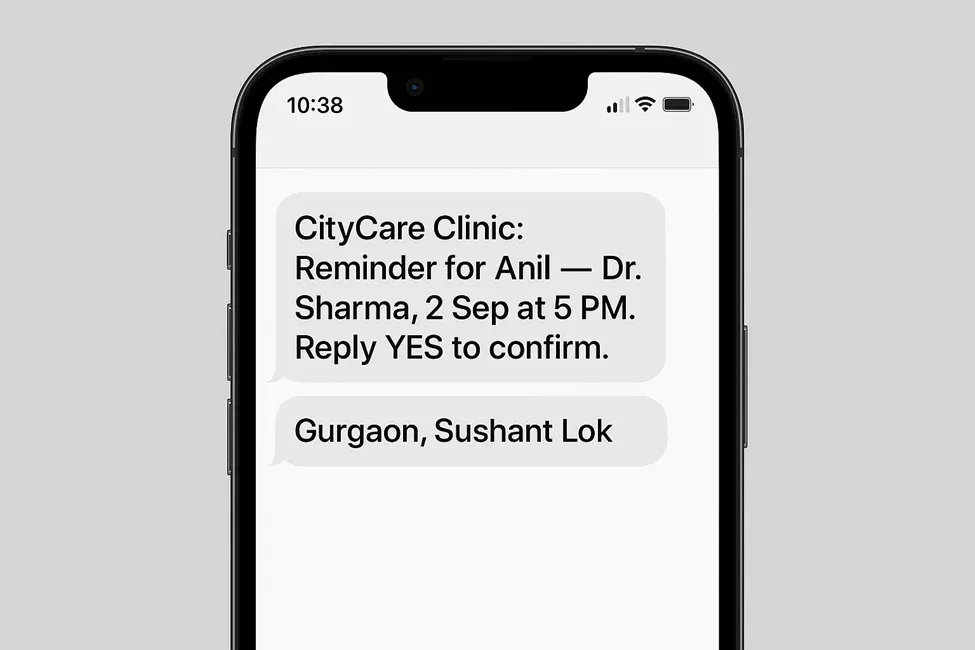
No-shows cost clinics time, revenue, and access to care --- and Gurgaon's fast-moving healthcare market is no exception. With Gurugram's private healthcare sector valued in the thousands of crores and heavy patient demand, clinics that reduce missed appointments gain immediate competitive advantage. BioSpectrum
This guide is written only for Gurgaon clinics and explains evidence-backed SMS reminder strategies that reduce no-shows, comply with Indian telecom rules, and fit local patient behaviour. I include working sources you can click, practical templates, recommended timing & frequency, implementation steps (DLT/TRAI compliance), and pick of Indian SMS vendors for clinics. Use this to build a low-friction reminder system that saves staff hours and fills appointment slots.

Multiple studies and systematic reviews show that SMS/text reminders reliably improve attendance compared with no reminder. Overall effect sizes vary by setting, but randomized and systematic evidence reports meaningful improvements in attendance and reductions in missed visits. One review of reminder systems concluded that text reminders increase attendance versus none. PMC
Industry case studies and provider data also suggest large practical reductions --- some implementations report no-show drops as high as ~30--40% when reminders are well timed and include simple CTAs. (Example: platform & clinic case studies).
What this means for Gurgaon clinics: reducing no-shows even by a few percentage points increases available appointment capacity and revenue in a high-demand market.

India requires businesses that send commercial or transactional SMS at scale to register on DLT platforms and pre-approve content templates and Sender IDs (headers). This prevents spam and protects patients. Before you send reminders you must:
- Register your entity and Sender ID on a DLT platform through a telecom operator or an authorized principal.
- Create and whitelist SMS templates (fixed text + variables like {patient_name}, {date}, {time}, {clinic_name}).
- Maintain documented patient consent for receiving reminders (consent capture during booking or registration).
Follow TRAI's guidance and your chosen DLT provider's process to avoid message blocking. TRAI
1) Timing & cadence (best practices)
- Primary reminder: 24--48 hours before the appointment --- this captures most patients who can cancel or confirm.
- Secondary reminder: 2--4 hours before the appointment for same-day confirmation (optional; useful for shorter-notice appointments).
- For high-risk no-shows (new patients, those with prior missed visit): add an additional reminder 5--7 days before with a polite confirmation CTA.
Evidence shows that multiple, short reminders outperform a single long message or complicated multi-step calls. Keep messages concise.
2) Message content --- short, clear, action-oriented
Use templates that are transactional (hence more likely allowed) and include:
- Clinic/doctor name and exact appointment date/time
- Simple CTA: "Reply YES to confirm / Call [number] to reschedule" or a booking link if available
- Location hint (sector/landmark) for Gurgaon patients (e.g., "near Sushant Lok / Golf Course Road") --- this boosts local clarity and reduces confusion
Example template (DLT-friendly variable form):
Register this exact template (with variable placeholders) in the DLT platform. TRAI
3) Personalization & language
- Personalize with patient name and doctor/specialty.
- Offer Hindi/Hinglish templates if a portion of your patients prefer it --- short bilingual alternatives boost comprehension for older patients in Gurgaon neighborhoods.
- For repeat no-shows, include a gentle helpful line ("If you need help rescheduling, call us on...") rather than punitive language.
4) Two-way options and rescheduling links
- Allow one-tap confirmation (reply YES) or an embedded short booking link that opens a prefilled reschedule form.
- If your clinic uses Practo / clinic management software, integrate the SMS link so confirmations auto-sync with your calendar. Platforms show higher conversion when patients can reschedule in one click. msg91.com
5) Segment & target
- Segment patients by risk (new vs repeat, prior no-show) and send slightly different cadences.
- Use analytics (appointment type, day/time) to send targeted reminders before high-no-show slots (e.g., early mornings or late evenings).

Pick an SMS provider that: supports DLT/Sender ID registration, has transactional SMS capability, offers APIs for scheduling & two-way replies, and provides delivery reports.
Popular Indian options used by clinics: MSG91, TextLocal, Kaleyra, MSG91/MSG91 transactional API, and local integrators --- all offer DLT support and healthcare use cases. Evaluate by price, SLA, and API ease.
If you already use an appointment platform (Practo, Practo-like platforms), check native SMS integration --- this often simplifies consent capture and reduces development overhead.
- DLT & Sender ID: Register clinic entity and Sender ID (header) on a DLT platform through your SMS vendor. smscountry.com
- Template Approval: Create and whitelist templates for reminders, confirmations, cancellations, and reschedule links. TRAI
- Consent Capture: Update booking flows (website, phone scripts, reception forms) to log consent for SMS reminders.
- Integration: Connect SMS provider to your booking system (Practo, clinic PMS or Google Calendar) for automated triggers. dialoghealth.com
- Segmentation Rules: Define rules (new patient, prior no-show, urgent slot) and set cadence.
- Reporting: Monitor delivery rates, reply rates, confirmations, cancellations, and the resulting change in no-show %.
- A/B Test: Try two templates or different timings for 4--6 weeks and keep the best performing approach.
- Staff SOPs: Create a short SOP for reception to handle cases where patients reply to SMS or need manual follow-up.
KPI measurement (what to track)
- No-show rate (monthly) --- primary KPI
- Confirmation rate (reply YES % / link click %)
- Reschedule rate via link (reduces phone time)
- Delivery rate & DLT template rejections (technical health check)
- Net appointment fill increase (new bookings from slots freed by cancellations)
Track before (baseline) and after (30/60/90 days) to measure impact.
Practical concerns & patient experience (Gurgaon specifics)
- Language: Many Gurgaon patients are comfortable with English, but older patients often prefer Hindi/Hinglish. Offer both templates when possible.
- Urban mobility: Provide landmark-based clarifications (e.g., "Opposite DLF Mega Mall, Sushant Lok") in reminder texts for new patients who may be unfamiliar with the clinic location.
- Data privacy: Keep PHI minimal in SMS. Use reference IDs and ask patients to call for clinical details --- SMS should be transactional not clinical in nature.
SMS reminders are one of the most studied and widely adopted tools in healthcare appointment management. Their impact has been validated across countries and contexts:
Global Research Evidence
- A Cochrane Review found that mobile phone text messaging increases attendance at healthcare appointments compared with no reminders, with reductions in missed appointments of 23--34% .
- A study in the Journal of Telemedicine and Telecare showed SMS reminders were as effective as phone calls but cheaper and less time-consuming for staff (PMC, 2008).
- Research in UK outpatient clinics recorded a 39% fall in missed appointments after implementing SMS reminders.
Impact for Doctors & Clinics
- Doctors: fuller schedules, less wasted consultation time, and stronger doctor--patient relationships.
- Clinics: measurable revenue increase by filling slots that would otherwise be lost.
- Admin teams: automation saves hours of staff calls and paperwork.
Indian Context
- In India, SMS remains the most accessible and universal channel with over 1 billion mobile connections.
- Platforms like Practo and MSG91 report their partnered clinics seeing 20--30% lower no-shows within 3--6 months of adopting SMS reminders.
For Gurgaon doctors: This isn't just theory --- SMS reminders are a proven, data-backed method to improve patient turnout, stabilize revenues, and optimize clinic efficiency.
Template A --- 24-48 hours before (English)
Template B --- 2 hours before (Short / Same day)
Template C --- Hindi (Hinglish) optional
Register these templates (with placeholders) on the DLT portal; do not deviate from approved wording after registration.
SMS reminders are a low-cost, high-impact intervention for Gurgaon clinics. By combining a DLT-compliant SMS program with clear templates, localized messaging, one-tap confirmations, and analytics, clinics can significantly reduce no-shows, increase realised appointments, and improve staff efficiency.
At Qaushik Labs, we help Gurgaon clinics reduce no-shows by managing the entire SMS reminder process --- from DLT registration and template approval to integration with booking systems like Practo or your clinic's PMS. We also design bilingual (English + Hindi/Hinglish) reminder flows and provide tracking dashboards so you can measure results quickly.
SMS reminders help Gurgaon clinics by sending timely alerts before appointments, reducing forgetfulness, improving confirmations, and allowing patients to reschedule in advance. Clinics using reminders often see 20--30% fewer no-shows.
Yes, Gurgaon clinics can legally send SMS reminders if they register on a DLT platform, approve templates, capture patient consent, and use transactional SMS routes. Following TRAI guidelines ensures delivery without penalties.
The ideal strategy is to send the first SMS 24--48 hours before the appointment, and a secondary reminder 2--4 hours before. High-risk or frequent no-show patients can also receive a reminder 5--7 days earlier.
Popular SMS vendors for Gurgaon clinics include MSG91, TextLocal, Kaleyra, and SMSCountry. These platforms support DLT compliance, transactional SMS, delivery reports, and integration with clinic software like Practo.
Yes, clinics in Gurgaon can send SMS reminders in English, Hindi, or Hinglish. Using bilingual templates helps reach older patients and increases response rates, while still keeping messages DLT-compliant.